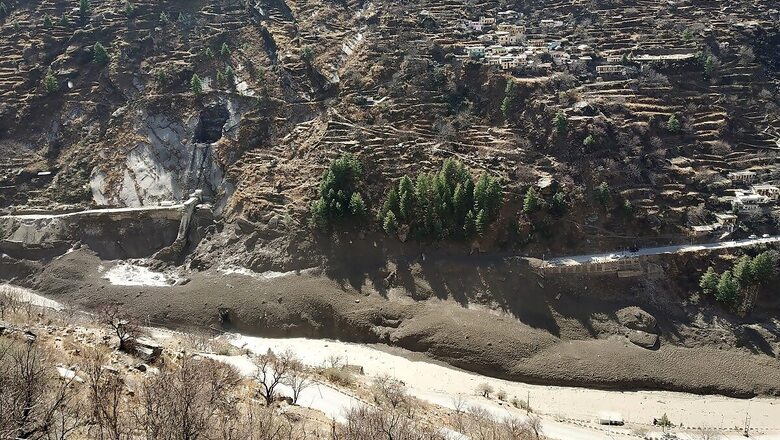
views
Nandadevi Glacier caused massive flooding in Uttarakhand on Sunday after a part of it broke off and swept away a hydroelectric dam and several houses on Sunday. With rising water levels, over 150 people have been reported missing and at least 10 have lost their lives so far.
Reportedly, labourers working at a power project in Tapovan-Reni are feared dead, an Indo Tibetan Border Police spokesperson told PTI. The power project was swept away completely, added state Director General of Police Ashok Kumar while describing the situation as under control. There were fears of damage in human settlements downstream, including in heavily populated areas. Many villages were evacuated and people were taken to safer areas.
Satellite and Google Earth images do not show a glacial lake near the region, but there is a possibility that there may be a water pocket, or lake inside the glacier, in the region that may have erupted leading to the disaster, Mohd. Farooq Azam, who is an Assistant Professor at IIT Indore, told news agency IANS.
It was not immediately clear what had set off the avalanche at a time when it is not the flood season. In June 2013, record monsoon rains in Uttarakhand caused devastating floods that claimed close to 6,000 lives.
Here is what we know so far:
What is Nandadevi Glacier and Was it a Climate Change Event?
The glacier forms part of the second-highest mountain in India. Actually, it is the highest that is located completely in India as Kanchenjunga is on the border with Nepal. In the world, it occupies the 23rd spot among the highest peaks. Above its southwestern base is the Dakkini Nandadevi Glacier. While on the Northern base, lies the Uttari Nandadevi Glacier. Covered completely with ice, a part of it breaking off has resulted in the flash floods, officials said.
Experts said it is a rare incident of a glacial burst, and may be “a climate change event”. “We need further analysis, weather reports and data to confirm if this indeed was the case. It’s unlikely that this was a cloudburst, since weather reports in Chamoli district show sunny weather till today with no record of precipitation,” said Mohd. Farooq Azam.
Another scientist, Anjal Prakash, who is the Research Director and Adjunct Associate Professor at the Indian School of Business in Hyderabad, said prima facie this looks very much like a climate change event.
What is glacial lake outburst flood?
According to the United Nations, a Glacial lake outburst flood (GLOF) is a phrase used to describe a sudden release of a significant amount of water retained in a glacial lake, irrespective of the cause. It is a type of outburst flood that occurs when water dammed by a glacier or moraine is released. In layman terms, the glacier containing the body of water melts and overflows the glacier.
It can be caused by several reasons, including rapid slope movement into the lake, heavy rainfall or snowmelt,
cascading processes (flood from a lake situated upstream), earthquake, melting of ice incorporated in dam/forming the dam or long-term dam degradation.
When Does a Glacier Break?
A glacier can break due to multiple reasons like erosion, the build-up of water pressure, an avalanche of snow or rocks, and also an earthquake under the ice. It can also happen if there is a massive displacement of water in the glacial area when a large portion of an adjacent glacier collapses. The direct causes of glacial lake outbursts are earthquake, heavy rainfall/snowmelt, long-term dam degradation, etc.
Read all the Latest News, Breaking News and Coronavirus News here



















Comments
0 comment